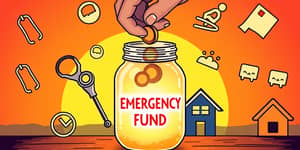In a world where traditional markers of success once centered on homeownership, luxury cars, or accumulating vast assets, a powerful societal redefinition has taken root: true financial victory lies in living debt-free. This shift is more than a passing trend—it reflects deep transformations in Americans’ values, goals, and daily realities. With 74% of Americans now citing debt freedom as their top milestone, the narrative of financial success is being rewritten.
At the same time, financial stress is surging to new heights. In 2025, 68% of Americans report being financially stressed, up from 50% just one year earlier. As the weight of debt grows heavier, understanding strategies for liberation becomes not only desirable but essential for long-term well-being and security.
The Shifting Landscape of Financial Success
For decades, success was measured by how much one owned. Today, however, surveys reveal a remarkable transformation: most people define their principal financial milestone by their ability to eliminate debt. This newfound priority has profound implications for personal budgeting, career choices, and life planning. Whether postponing a dream vacation or delaying home improvements, more individuals are ready to make sacrifices to become debt-free.
Yet this revolution in mindset comes with its own challenges. Rising costs of living, stagnant wages in certain sectors, and global economic uncertainties have all conspired to maintain or even increase debt levels. The changing cultural narrative now places resilience and flexibility above accumulation—building a safety net over chasing luxury—a shift that’s urgent in an unpredictable economy.
The State of American Debt: Numbers, Demographics, and Realities
Despite the desire for debt freedom, only 23% of Americans report having no debt whatsoever. For the rest, mortgages, credit cards, student loans, and medical bills form a complex web of obligations that can feel impossible to untangle.
- Mortgage debt remains the largest single burden for many households.
- Credit card balances are carried by nearly half of all consumers, with 33% owing more on cards than they have saved.
- Student loans and medical debts force difficult choices between health, education, and financial stability.
Generational patterns underscore distinct challenges. Millennials lead in credit card burdens, with 42% carrying more plastic debt than emergency savings. Gen Xers follow closely at 39%, while baby boomers are relatively better off at 24%. Interestingly, Gen Z shows dual extremes: they are the most likely to have no debt or any savings, reflecting both a fresh entry into adulthood and cautious spending behaviors.
Why Debt Freedom Matters
Debt is more than a financial metric: it permeates mental health, life trajectory, and even relationships. Over half of Americans worry that debt will erode long-term plans, from starting a family to securing comfortable retirement. Another 48% fear that it will derail critical milestones entirely.
For those with high credit card or medical debt, the struggle can feel unending. Sixty percent of heavy card users and 70% of those with large medical bills report difficulty managing payments, leading to anxiety, strained relationships, and compromised well-being. The broader consequences include postponed home purchases, delayed education, and even declining physical health when medical treatments are deferred.
Ultimately, freedom from debt equates to peace of mind and renewed opportunity. When obligations no longer overshadow income, individuals gain the capacity to invest in passions, support loved ones, and build lasting wealth.
Core Strategies for Achieving Financial Liberation
While the goal of being debt-free can feel monumental, proven methods and disciplined practices light the path to success. Professionals and everyday savers alike rely on structured approaches to dismantle debt burdens efficiently and sustainably.
- Avalanche Method: Prioritize debts with the highest interest rates first, reducing total interest paid over time.
- Snowball Method: Pay off your smallest balances initially for psychological momentum and quick wins.
- Debt Consolidation: Combine multiple debts into a single loan at a lower rate to simplify payments and reduce interest.
- Expense Reduction: Trim discretionary costs—dining out, streaming subscriptions, nonessential shopping—and channel savings to debt.
- Income Boosting: Pursue side gigs, freelance projects, or part-time work to accelerate payoff timelines.
Key to these strategies is unwavering discipline: avoid acquiring new debt and consistently pay off card balances in full. Tracking progress through budgeting apps or spreadsheets ensures accountability and highlights momentum, turning abstract goals into tangible milestones.
Overcoming Barriers on the Path to Debt Freedom
Even with a clear plan, hurdles can arise. Excessive expenses and existing high debt levels rank as the most common obstacles, cited by 38% and 30% of Americans respectively. Many find that housing costs and student loan payments leave too little room for significant principal reductions.
Medical debt adds another layer of complexity, often requiring delicate negotiation with healthcare providers or installment plans. Some must resort to deferments or forbearance, which can temporarily relieve pressure but increase long-term costs.
Recognizing these barriers is a critical first step toward overcoming them. By identifying specific challenges—whether it’s high rent, irregular income, or unexpected medical expenses—individuals can tailor their actions, such as seeking lower-cost housing, pursuing gig work with predictable hours, or setting aside smaller emergency reserves.
The Role of Financial Resilience and Emergency Savings
Debt freedom is inseparable from the concept of financial resilience. It’s not enough to simply eliminate obligations; one must also prepare for unforeseen setbacks. Building an emergency fund while reducing debt might seem like walking a tightrope, but it’s vital for long-term stability.
Approximately 53% of Americans already have more savings than credit card debt, showcasing the feasibility of balancing these priorities. Financial advisors often recommend setting aside a small lump sum—around one month of living expenses—before focusing exclusively on debt. This buffer prevents new loans to cover sudden costs and keeps the snowball rolling.
Professional guidance plays a key role in crafting personalized plans. About 25% of Americans enlist certified advisors for tailored debt management and holistic wealth planning, reflecting a growing demand for expert, data-driven financial education that empowers lasting change.
The Future Outlook: Trends, Generational Shifts, and Lasting Liberation
As we look ahead, the cultural tide toward financial resilience over rigid accumulation shows little sign of ebbing. Younger generations, particularly Gen Z, display the highest rates of zero debt, suggesting that early education and cautious entry into credit may yield long-term benefits.
Meanwhile, even high earners grapple with liquidity constraints. Among six-figure households, 68% hold $10,000 or less in checking and savings, highlighting that income alone does not guarantee freedom from financial strain. This paradox underscores the need for robust budgeting, smart repayment schemes, and a resilient mindset.
Ultimately, the journey to a debt-free future is both personal and collective. It hinges on individual choices, systemic changes in lending and education, and a societal embrace of resilience as the new bedrock of success.
Stepping into the debt-free future demands both strategy and spirit. It requires a willingness to confront hard truths, adjust deeply held habits, and embrace the discipline of incremental progress. Yet the prize—a life unshackled by financial burdens—is well worth the effort.
By combining tested repayment methods, disciplined budgeting, emergency savings, and expert guidance, individuals from every walk of life can unlock lasting financial liberation and peace of mind. The path may be challenging, but it leads to a brighter horizon where personal aspirations flourish, unencumbered by the chains of debt.
References
- https://rbj.net/2025/11/11/keybank-financial-mobility-survey-2025/
- https://www.nationaldebtrelief.com/blog/financial-wellness/financial-education/in-america-debt-free-life-is-possible/
- https://finance-commerce.com/2025/11/americans-redefine-financial-success-as-debt-free-living/
- https://www.cfp.net/news/2024/12/reducing-debt-is-americans-no-1-financial-priority-for-2025-cfp-board-research-finds
- https://www.bankrate.com/banking/savings/emergency-savings-report/
- https://bhgfinancial.com/personal-loans/debt-consolidation/more-high-earners-turning-to-debt-consolidation










